Protect your cards for life while adding value by submitting trading cards to a third-party service for proof of authenticity (not a counterfeit/reprint). From there, it will be graded on a scale of 1 to 10 based on the quality of the card which includes centering, corners, cut, colour, borders, enamel, focus, picture quality, registration and micro imperfections. Cards are measured, checked under magnification and special lighting to achieve the grade. Once assigned an overall grade, it is sealed in a tamper-proof holder and assigned a serial number.
There any many companies that grade cards. The most recognized is PSA and Beckett. These two companies tend to bring in the highest value on graded cards in our opinion only. Below is a brief description of each:

1) Professional Sports Authenticator (PSA) – The oldest and most popular. PSA grades cards on a scale of 1-10 with no half points. Long established as the leader in third-party grading, PSA’s advantages are many, including their Set Registry, which allows you to register and build your PSA-graded sets online, competing with others.
PSA’s popularity extends across both vintage and modern cards in all sports. While there has been some question about PSA’s consistency, this is to be somewhat expected with a company that grades such a huge volume of cards. Incidentally, their message boards are an excellent source of information on all aspects of the card collecting hobby.
2) Beckett Grading Service (BGS)/Beckett Vintage Grading (BVG) – BGS is widely considered the top choice among modern card collectors.
BGS early on earned a reputation for being the toughest of the grading companies. However, this reputation has slipped recently, as Pristine grades, once nearly unheard of, are more commonplace on the market.
BGS uses a grading scale from 1 (Poor) to 10 (Pristine), including half points, and also provides subgrades for the corners, edges, centering and surface so you know exactly what a card’s strengths and weaknesses are. Your own personal stance will help to determine whether you will consider BGS when shopping for graded cards.
BVG is Beckett’s second grading service that grades vintage cards. BVG has had a tough time gaining a foothold in the vintage grading world, which is not a surprise given the lack of coverage that vintage cards receive in their publications, however it is an increasing market.
BCCG (Beckett Collectors Club Grading) is their third grading service. BCCG offers a simplified 1-10 scale with no half grades and no subgrades.
The following Grading Scale is a representation. Each card is unique therefore there may be exceptions to this criteria when applying the card with a certain grade.
Grade 10 – Condition GEM MINT (GEM) – Perfect in every respect; centering 50/50 top to bottom and side to side and no worse than 60/40 on the back, sharp corners and edges, bright colour, glossy surface, good picture focus and registration.
A perfect example of a Gem Mint Card is this Wayne Gretzky Rookie which sold for a record breaking $465,000 in August 2016 at auction and is the only one on record as a GEM Mint or perfect 10 to date.
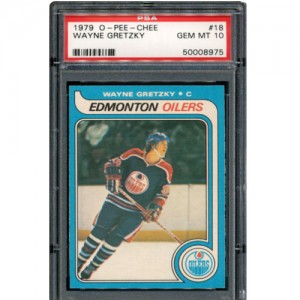
Grade 9.5 – Condition NEAR GEM MINT (NGM) – All qualities of the above; centering should be 50/50 top to bottom or side to side or better than 55/45. This card will have one minor imperfection.
Grade 9 – Condition MINT – Has similar characteristics to the ones above; centering is 55/45 or better on the front and better than 70/30 on the back, it will have one minor flaw such as a printing imperfection or a slightly rough edge.
A great example of this card is a 1954 Gordie Howe Topps. It is a rarer card to find from the 1954 set and can go for as much as $13,000 at auction.
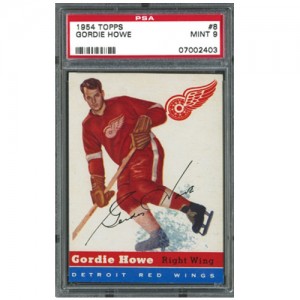
Grade 8.5 – Condition NEAR MINT TO MINT+ (NMM+) – Similar to 9 Mint card with centering better than 60/40 on the front and 90/10 or better on the back; may have a corner with a slight bit of white showing, one or two minor flaws such as printing imperfections which could be a print line on the back of the card or a hard to see surface scratch, or a chip on the edge.
Grade 8 – Condition NEAR MINT TO MINT (NMM) – Centered no worse than 60/40 on the front and 90/10 or better on the back, may have one or two corners with a slight touch of wear, a wax mark or hard to see surface marks may be part of the two or three minor imperfections of this card, colour, borders, edges, picture quality and registration are near perfect.
For a NMM 8 Card look no further then the 1966 Topps set as this is the only recognized rookie card of the NHL’s greatest defenceman, Bobby Orr. If you are able to find on in this condition of higher, you’ll be looking at a minimum of a $100,000 payday at auction.
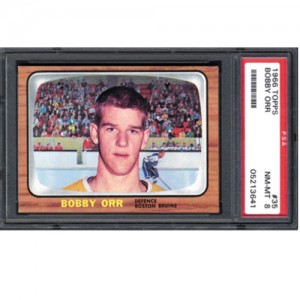
Grade 7.5 – Condition NEAR MINT+ (NM+) – Similar to 8 NMM card with centering 65/35 or better on the front, one or two corners show slight fraying and may be angle cut.
Grade 7 – Condition NEAR MINT (NM) – Centering no worse than 70/30 on the front, two or three corners showing slight wear, may be surface scratches some being visible, will be two or three other minor imperfections with the edges, colour borders, picture quality and registration.
Below is a NM card for Toronto Maple Leafs legend George Armstrong. Currently his card at this shape are selling for $1000.00 or more.
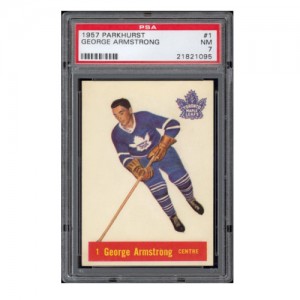
Grade 6.5 – Condition EXCELLENT TO NEAR MINT+ (ENM+) – Centering is 80/20 or better, three corners may show slight wear, may have slight surface wear, small wrinkle on one side, a wax mark, stain or slight surface scratches.
Grade 6 – Condition EXCELLENT TO NEAR MINT (ENM) – Similar to 6.5 ENM+ card mostly with some differences including entering 90/10 on the front, three or four corners showing slight wear, may have some surface wear, light scratches or a wrinkle on one side only.
Below is a ENM Card for another Toronto Maple Leafs legend, Frank Mahovlich, this card recently sold on EBay for $775.00
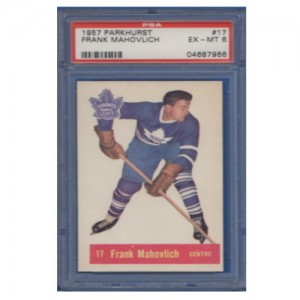
Grade 5 – Condition EXCELLENT (EX) – This card is slightly used and/or major off-centered. Corners are fuzzy or slightly rounded. There is surface wear and edges may be chipped, there is loss of original gloss and there may be scratches, borders may be off colour, may be a slight crease on one side but not completely through, the picture focus, colour and registration may also have imperfections.
Grade 4 – Condition VERY GOOD TO EXCELLENT (VGE) – Similar to 5 EX card except corners are more rounded and the card may show more wear, may be a crease on the front or the back, may show a stain.
Grade 3 – Condition VERY GOOD (VG) – Corners are round, surface wear of up to half the card which could include scuffing and scratches, may be more than one crease on the front and back, major loss of gloss and stains, edge wear and discolouration are more noticeable.
Grade 2 – Condition GOOD (G) – Similar to a 3 VG card with more obvious wear and multiple creases, may be scratches, discolouration, light stains, and graffiti.
Grade 1 – Condition POOR (P) – Shows extreme wear and heavy creases, major round corners and other damage could include scuffing, staining, chipped edges, graffiti and discolouration, may even be missing small pieces from the card.
As you can see the lower the grade the less the cards is worth, however our suggestion is to take a look at your collection and get some of those cards graded. Not only are they worth more than non graded cards, you never what investments you may have!
The post Trading Cards – Beginners Guide to Grading appeared first on Slapshot Signatures.
No comments:
Post a Comment